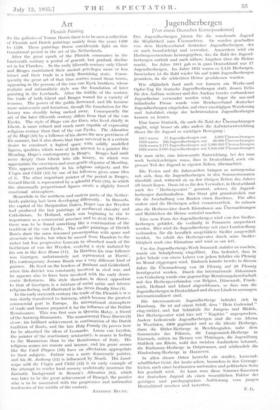Art
Flemish Painting AT the galleries of Tomas Harris there is to be seen a collection of Flemish and Dutch paintings mainly from the years 1480 to 1530. • These paintings throw considerable light on this transitional period in the art of the Netherlands.
After the great epoch of the Flemish communes in the fourteenth century a period of general, but gradual, decline set in lOr, Flanders. In the early fifteenth century only Ghent and Bruges maintained their ancient privileges more or less intact and their trade in a fairly flourishing state. Conse- quently the great art of that time centres round those towns, appearing in the persons of the two van Eyck brothers, whose realistic and rationalistic style was the foundation of later painting in the Lowlands. After the middle of the century the trade of both Ghent and Bruges waned for a variety of reasons. The power of the guilds decreased, and life became more aristocratic and luxurious, though the foundation for the luxury was steadily being sucked away. Consequently the art of the later fifteenth century differs from that of the van Eycks. The style of Hugo van der Goes, who lived chiefly in Ghent, is more refined and much more capable of expressing religious ecstasy than that of the van Eyeks. The Adoration of the Magi (10) by a follower of his shows the new prettiness of his manner, but it also shows that there survived in it a certain desire to construct a logical space with solidly modelled figures, qualities which were of little interest to a painter like Memling, Hugo's contemporary in Bruges. Bruges had sunk more deeply than Ghent into idle luxury, to which was appropriate the sweetness and over-gentle elegance of Memling. This appears particularly in his religious subjects and the Virgin and Child (15) by one of his followers gives some idea of it. The other important painter of the period in Bruges, Gerard David, is represented by a splendid Pieta (16), in which the abnormally proportioned figures create a slightly forced emotional atmosphere. Meanwhile in the northern and eastern parts of the Nether- lands painting had been developing differently. In Brussels, the capital of the Burgundian Dukes, Roger van der Weyden had produced the last paintings of mediaeval chivalry and Catholicism. In Holland, which was beginning to rise to importance as a commercial province and to rival the Hanse, there was to be found something like a continuation of the tradition of the van Eycks. The earlier paintings of Dierick 'lints show the same reasoned preoccupation with space and structure as theirs, but when he moved from Haarlem to the richer but less progressive Louvain he absorbed much of the Gothicism of van der Weyden, evolving a style imitated by his son in the Ecce Homo (11). In Haarlem his true follower was Geertgen, unfortunately not represented at Harris'. His contemporary Jerome Bosch was a very different kind of painter. He lived on the borders of Brabant and Gelderland, when this district was constantly involved hi civil war, and he appears also to have been involved with the early demo- cratic Reformers. His style therefore, in direct opposition to that of Geertgen, is a mixture of .social satire and intense religiOus feeling, well illustrated in the Seven Deadly Sins (4). In the early sixteenth century the trade of the Flemish IA w.is was slowly transferred to Antwerp, which became the greatest coiiunercial port in Europe. Its international atmosphere of trade and finance prepared it for the influence of the Italian Renaissance. This was first seen in Quentin Matsy, a friend of the Antwerp Humanists. The monumental Three Maries (2) show3 his brilliant achievement in continuation of the Dutch tradition of Bouts, and the late Holy Family (8) proves how far he absorbed the ideas of Leonardo. Lucas van Leyden, the painter of the reactionary aristocracy, is nearer in feeling to the Mannerism than to the Renaissance of Italy. His religious scenes are remote and intense, and his genre scenes like the Card Players (19) have an affectation appropriate to their subjects. Patinir" was a More demberatie painter, and his St. Anthony (12) is influenced by Bosch. His Land- scape with the Virgin and Child (13) is an early example of the attempt to render local scenery realistically (contrast the fantastic background in Benson's Adoration (8)), which was later to be the great achievement of Bruegel; the painter who is to be associated with the progressive and nationalist tendencies of the middle of the century. ANTUONY BLUNT.










































 Previous page
Previous page